The Plastics Pipe Institute, Inc. (PPI), has published a new recommendation related to the direct connection of plastic piping materials CPVC, PE-RT, PEX, and PP to tankless water heaters. Available on PPI’s website, PPI Recommendation H Direct Connection of Plastic Piping Materials to Tankless Water Heaters for Domestic (i.e. residential) Applications provides clear guidance on Read more
tankless water heaters
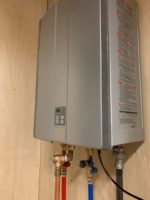
The Plastics Pipe Institute, Inc. (PPI), has published a new recommendation related to the direct connection of plastic piping materials CPVC, PE-RT, PEX, and PP to tankless water heaters.
Available on PPI’s website, PPI Recommendation H Direct Connection of Plastic Piping Materials to Tankless Water Heaters for Domestic (i.e. residential) Applications provides clear guidance on the question of direct connection of these piping materials to tankless water heaters. PPI is the major trade association representing the plastic pipe industry.

“PPI Recommendation H answers questions which plumbers and builders have been asking about whether it is appropriate for plastic pressure pipe materials to connect directly to the cold-water inlet and hot-water outlet of domestic tankless water heaters, without the use of metallic flex connectors. Based on our research, these direct connections are usually acceptable,” explained Lance MacNevin, P. Eng., director of engineering for PPI’s Building & Construction Division.
“To help answer this question, PPI and our members researched Canadian and US model plumbing codes,” he continued, “reviewed the published literature on dozens of tankless water heaters, and confirmed the recommendations of plastic piping system manufacturers. Based on the proven high-temperature capabilities of these piping materials and the relatively consistent water temperature control of modern tankless water heaters, there is no technical reason to prohibit direct connections. Of course, installers must follow local code requirements and the manufacturer installation instructions.”
“As stated in Recommendation H: Piping systems using the materials CPVC, PE-RT, PEX, and PP, which carry a pressure rating of 100 psi at 180°F (690 kPa @ 82°C), and which are intended and certified for hot and cold potable water distribution systems according to industry standards and relevant codes, may be connected directly to tankless water heaters which are intended for domestic (i.e. residential) applications, unless prohibited by local plumbing code or the specific water heater manufacturer.”
According to PPI President David Fink, “The research on this topic was prompted by an inquiry from a major builders group. The rapid development of Recommendation H demonstrates the ability of PPI members to collaborate and respond quickly to industry questions about responsible usage of plastic piping materials.”
Published on PPI’s website directly at recommendation-h-direct-connection-tankless, Recommendation H is one of several PPI documents related to the design and installation of pressure pipe materials for plumbing and mechanical applications, which are all published as a service to the industry. Additional information about PPI’s Building & Construction Division can be found at plasticpipe.org/building-construction/index.html.
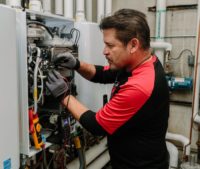
With an enrollment of more than 27,000 students, the University of New Mexico is the state’s largest college. It’s known for its strong and historied athletic programs, particularly the Lobos football and basketball teams, which compete in the Mountain West Conference. Dreamstyle Stadium has been home to the Lobos football team for 60 seasons. The Read more
With an enrollment of more than 27,000 students, the University of New Mexico is the state’s largest college. It’s known for its strong and historied athletic programs, particularly the Lobos football and basketball teams, which compete in the Mountain West Conference.
Dreamstyle Stadium has been home to the Lobos football team for 60 seasons. The 39,224 seat football stadium is attached to the L.F. Tow Diehm Athletic Facility. Tow Diehm, who’s known as the “Father of Athletic Training” in New Mexico, served as UNM’s athletics trainer for 31 years.
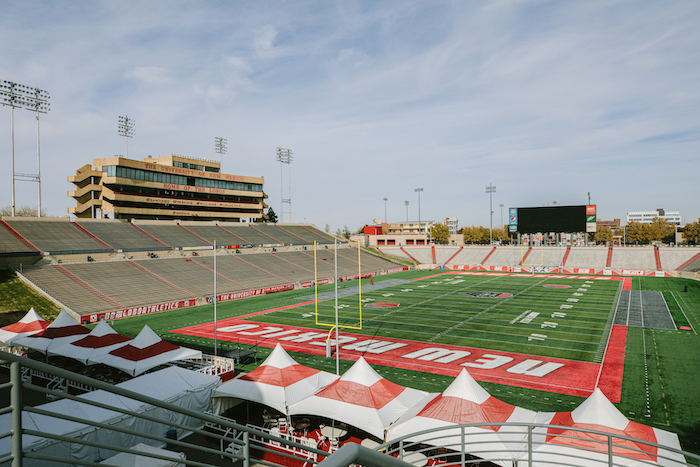
Inside, the facility includes athletic offices, common areas, locker rooms for both home and visiting teams, and a weight room that underwent an $800,000 renovation in 2014.
A more recent renovation took place in the facility’s primary mechanical room. Over the past few years, the domestic hot water system began failing. Nonstop pump failures, electrical problems, and a leaking hot water storage tank plagued maintenance crews.
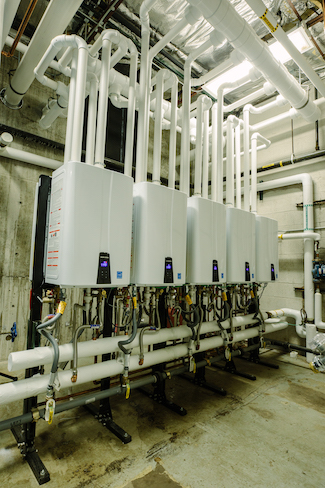 These problems inevitably surfaced at the worst times, like game day. The system provides hot water to all fixtures within the building, including the home and visitor locker room showers.
These problems inevitably surfaced at the worst times, like game day. The system provides hot water to all fixtures within the building, including the home and visitor locker room showers.
“We were frequently called in after hours to tend to the old system,” explained Richard Van Damme, HVAC master for the University of New Mexico. “At one point, we had even drained the 1,600 gallon storage tank for replacement, only to fill it again a few days later for game.”
Hot water was being supplied by two large, atmospheric volume water heaters with capacities of 490,000 BTUH each. The maintenance department had been pushing for replacement for a number of years. The cost of maintenance was rising, outright failure was imminent, the system’s dependability was lacking and efficiency was a concern.
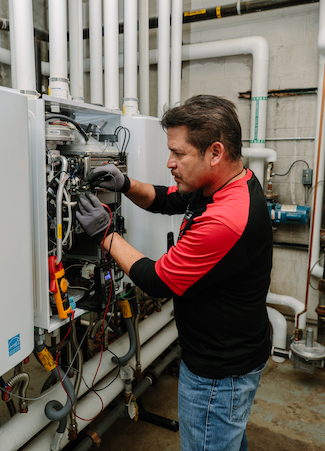
“When we received a work order to replace the failing system, we evaluated a straight, in-kind replacement with standard efficiency water heaters. Installing a similar storage tank would’ve required removing part of the roof. We also looked at tankless style system options. Energy savings was a big consideration, as was redundancy and serviceability,” said Jesse Hart, facilities engineer for UNM’s facilities management department.”
“There are short periods of high demand, with low or no demand otherwise,” he continued. “The showers aren’t even used year-round, so the application lent itself perfectly to a hi-efficiency, low-volume hot water system. Standby heat loss from the big tank was significant.”
UNM looked at various tankless products and contacted their local Navien representative, Jordan Mahboub, at RepNet. Mahboub and Hart worked closely with Navien sales engineers to create a design based on the peak hot water demand at the L.F. Tow Diehm Athletic Facility: 82 gallons per minute at 120F. The university wanted the ability to meet peak demand with one or two units offline.
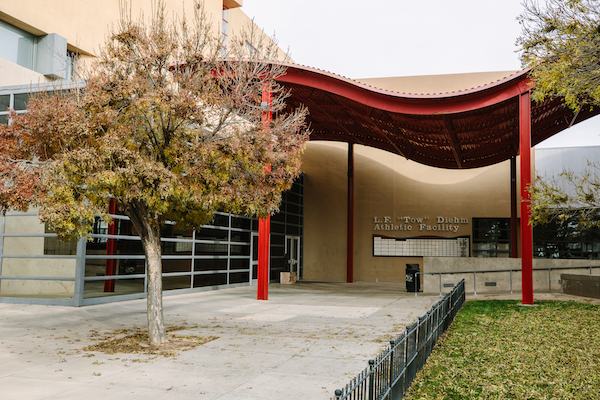
Once the design was approved, Futures Mechanical was hired for the replacement. The volume water heaters and storage tank were removed and 18 Navien NPE-240S condensing, tankless water heaters were installed.
The NPE-240S is a 199,900 BTUH condensing, wall-hung water heater that features dual stainless steel heat exchangers, a 10-to-1 turndown ratio, and efficiencies up to 97 percent. The unit also provides LEED points, where applicable.
Water heaters were installed in two independent systems, one on either side of the mechanical room to serve each locker room. Navien’s Ready-Link manifold system was used to simplify the installation and save space.
The Ready-Link Manifold System provides everything required for a multi-unit installation, including manifolds for water and gas, racks for floor mounting, valves, connections and flex lines.
Up to 16 NPE-240 units can be common vented, so only four roof penetrations were needed at the athletic facility.
“No intricate programming was needed to cascade this many units in a single system,” said Van Damme. “By using the factory-supplied cascade cable, the logic built into the units does all the thinking. If for some reason the master unit goes down, the next unit in line takes over, so there’s no downtime in the event of a unit failure.”
“Having Jordan Mahboub here during commissioning helped us learn all the advantages of the Navien system,” Van Damme continued. For example, each rack requires a single gas regulator, not every unit. The manifold system lets us isolate any unit in the group for service without taking the others off-line.”
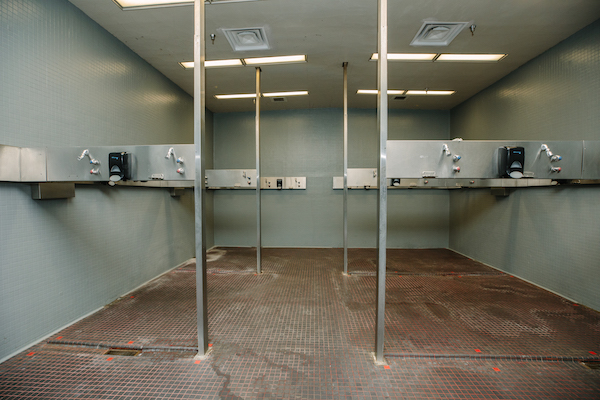
When the new system was tested, every hot water fixture in the facility was opened for almost two hours. The units cascaded to meet demand, but never fired to 100%. According to Van Damme, full capacity was met and sustained while the systems are operating at 60% input.
“The modulating component was a feature we really wanted,” Hart said. “Each of these units provides a 10-to-1 turndown, so no matter if there’s one sink or 20 showers running, we can accurately match the load. We’re not using energy beyond what’s needed to meet the actual demand. Now that the system has been operational for over a year, we’ve found an annual natural gas savings of 2,282 Therms.”
The entire project took three months over the 2018 summer break. The installation was seamless, and was completed just in time for football season. There’s now more space to service the water heaters or work on other equipment within the room.
“I think this system is a great asset to the stadium,” Van Damme said. “The money saved on maintenance alone is significant. We’ve been so impressed with these units that we’ve decided to use Navien systems in other locations across campus.”
Irvine, CA – Navien has added to their website, NavienInc.com, the ability to view the website in Spanish. In an effort to make more information available to Spanish speaking visitors, Navien has gone through a grand project of translating the entire NavienInc.com website along with brochures, manuals, guides and more. Visitors can now search for installers in Read more
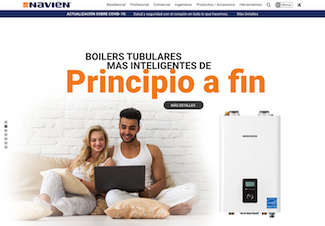 Irvine, CA – Navien has added to their website, NavienInc.com, the ability to view the website in Spanish. In an effort to make more information available to Spanish speaking visitors, Navien has gone through a grand project of translating the entire NavienInc.com website along with brochures, manuals, guides and more. Visitors can now search for installers in their area, register a Navien product, learn about Navien tankless water heaters, combi-boilers or boilers and much more on the website in either English or Spanish. To access the Navien website in Spanish, click on language within the main navigation at the top of the website and select, or directly visit the website in Spanish by going to NavienInc.com/es.
Irvine, CA – Navien has added to their website, NavienInc.com, the ability to view the website in Spanish. In an effort to make more information available to Spanish speaking visitors, Navien has gone through a grand project of translating the entire NavienInc.com website along with brochures, manuals, guides and more. Visitors can now search for installers in their area, register a Navien product, learn about Navien tankless water heaters, combi-boilers or boilers and much more on the website in either English or Spanish. To access the Navien website in Spanish, click on language within the main navigation at the top of the website and select, or directly visit the website in Spanish by going to NavienInc.com/es.
Washington — The Propane Education & Research Council released a video for commercial builders and contractors that provides a comprehensive overview of tankless water heaters. The video details how the systems work, their role in meeting LEED certification, and more. https://youtu.be/A24yGp-dUek “Many commercial building owners and operators are finding tankless water heaters to be a valuable Read more
Washington — The Propane Education & Research Council released a video for commercial builders and contractors that provides a comprehensive overview of tankless water heaters. The video details how the systems work, their role in meeting LEED certification, and more.
“Many commercial building owners and operators are finding tankless water heaters to be a valuable investment — whether in retrofits or new construction projects,” said Bryan Cordill, director of residential and commercial business development at PERC. “These systems are bringing significant space and energy savings to businesses across the country, especially as tankless technology continues to evolve. This video helps showcase how propane tankless systems can be a solution for a wide variety of commercial building types.”
The video outlines the importance of maximizing space and efficiency in commercial buildings, given that water heating is a major energy consumer in many buildings — particularly older buildings in need of renovations. In fact, nearly 80 percent of water heating energy use occurs in buildings built before the year 2000.
Current water heating technology, especially propane tankless systems, can offer big improvements in terms of performance, energy use, and energy costs. Plus, they’re versatile, so tankless technology for commercial buildings can meet a wide range of load types. As outlined in the video, individual tankless units can be combined into larger configurations, allowing them to provide hot water rates of several hundred gallons per minute — and ultimately, the ability to handle water heating no matter the size or scope of a building.
Visit Propane.com/Commercial-Buildings to learn more about the advantages of going tankless in commercial buildings.
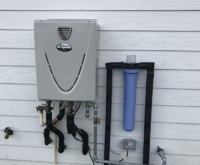
Drew Copeland is the rhythm guitarist and harmony vocalist for the rock band Sister Hazel — and the co-writer of the band’s biggest hit “All For You” that topped the charts in the late ’90s. Even though he’s made his living in music, Copeland knows quite a bit about homebuilding and energy efficiency because he Read more
Drew Copeland is the rhythm guitarist and harmony vocalist for the rock band Sister Hazel — and the co-writer of the band’s biggest hit “All For You” that topped the charts in the late ’90s.
Even though he’s made his living in music, Copeland knows quite a bit about homebuilding and energy efficiency because he received a building science degree from the University of Florida. His first exposure to A. O. Smith excellence was when he participated in the Hootie & The Blowfish celebrity golf tournament that the company co-sponsored.
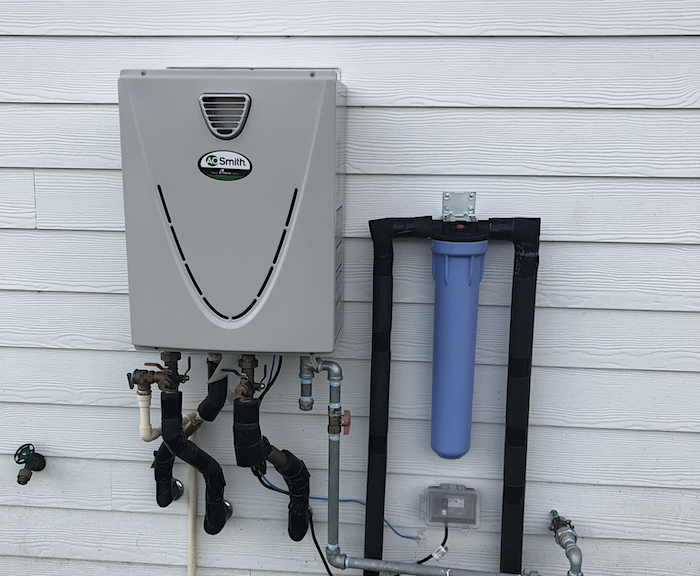
In 2018, Copeland began building two houses on a large lot outside of Gainesville, Florida. The larger house is for Drew and his wife and three children. It has 3,500 square feet of heated/cooled space. The smaller, 1700-sq. ft. house is for Copeland’s sister-in-law who was involved in a serious accident and requires a caretaker. Copeland went with two propane A. O. Smith ProLine XE Gas Tankless Water Heaters in the larger house and one in the smaller house. “When people ask me why I chose A. O. Smith, the answer was easy,” said Copeland. “A. O. Smith’s reputation of the highest quality in equipment as well as customer service made my decision very easy.”
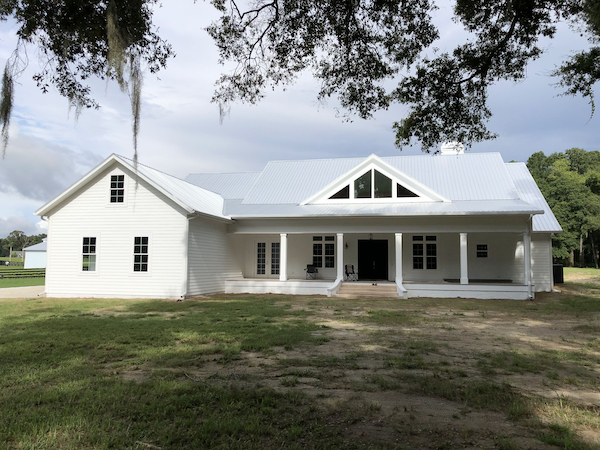
“I’m really excited about getting instantaneous hot water with the A. O. Smith units,” said Copeland. “In previous homes we had tank-type water heaters. With teenage kids, especially on hair-washing days, my chances of getting a hot shower were pretty slim,” he said. “In our new house, there are 4½ baths, and a need for hot water in the kitchen, laundry room and the summer kitchen outside and our outdoor shower. That’s a high demand, but the A. O. Smith tankless units have performed very well.”
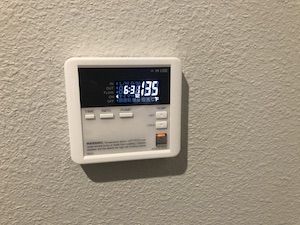 Despite its smaller size, the adjacent house also has high demand for hot water. “My sister-in-law’s house has a big sink and dishwasher, plus a washer and dryer in the laundry room,” said Copeland. “There are also two bathrooms in the house – one for the caretaker. We’ve been pleased with the performance of the A. O. Smith tankless unit in that house, too.”
Despite its smaller size, the adjacent house also has high demand for hot water. “My sister-in-law’s house has a big sink and dishwasher, plus a washer and dryer in the laundry room,” said Copeland. “There are also two bathrooms in the house – one for the caretaker. We’ve been pleased with the performance of the A. O. Smith tankless unit in that house, too.”
All the tankless units at the two homes are equipped with A. O. Smith Product Preservers that protect them from damage due to scale formation and make maintenance fast and hassle-free.
There’s a song called “Happy” on Sister Hazel’s best-selling album – and Copeland is indeed happy with the service and expertise that A. O. Smith provided. “The A. O. Smith team has really made the installations effortless,” added Copeland. “They came out to my site and helped me figure out exactly what I needed. I can’t sing their praises enough.”
